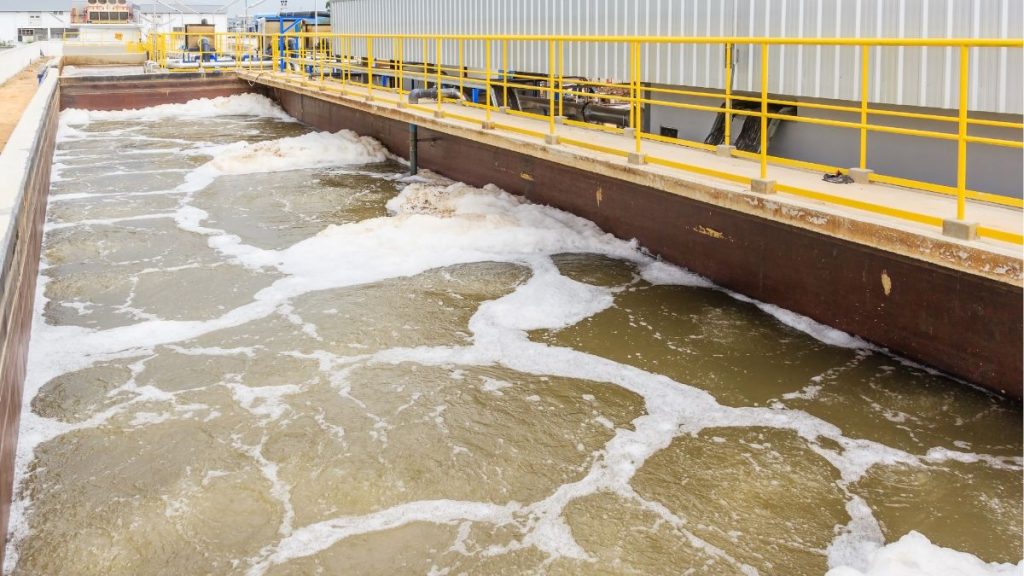In the world of wastewater treatment, the terms aerobic and anaerobic wastewater treatment refer to two main biological approaches to breaking down organic matter in waste.
These two methods have different characteristics, mechanisms, and advantages, and choosing the right system depends heavily on the type of waste, the final treatment objective, and the desired operational efficiency.
What Are Aerobic and Anaerobic Wastewater Treatment?
Aerobic wastewater treatment is a wastewater treatment process that involves aerobic microorganisms, namely microorganisms that require dissolved oxygen (DO) to survive and decompose organic matter. In this system, oxygen is usually supplied mechanically using aerators or blowers to create an optimal environment for the decomposing bacteria.
In contrast, anaerobic wastewater treatment involves anaerobic microorganisms that can survive and function without oxygen. This process tends to be slower, but it produces a byproduct in the form of biogas (primarily methane), which can be used as a renewable energy source.
Aerobic Wastewater Treatment Systems
Aerobic treatment systems are widely used in both domestic and industrial wastewater treatment applications, especially when efficient removal of organic matter (BOD, COD) and nutrients such as nitrogen and phosphorus is a top priority.
Some examples of commonly used aerobic treatment systems:
1. Activated Sludge System: This is the most common system, using mechanical aeration to provide oxygen for microorganisms that decompose organic matter.
2. Trickling Filter: Wastewater is passed through a porous medium where microorganisms grow to form a biofilm and aerobically decompose contaminants.
3. Membrane Bioreactor (MBR): An advanced technology that combines aerobic biological processes and membrane filtration to produce very high-quality wastewater.
The main advantages of aerobic systems are high efficiency in BOD reduction, minimal odor contamination, and the ability to be designed with a smaller footprint than anaerobic systems. However, energy consumption for aeration is relatively high.
Read Also: How to Prevent Algae in Cooling Water Systems
Anaerobic Wastewater Treatment Systems
Anaerobic treatment systems are often chosen to treat waste with high concentrations of organic matter, such as from the food and beverage industry, livestock farming, and agro-industry. This process occurs without oxygen supply and produces biogas as a byproduct.
Some examples of anaerobic treatment systems:
1. Upflow Anaerobic Sludge Blanket (UASB): Liquid waste flows from the bottom up through a layer of activated sludge containing anaerobic microorganisms.
2. Anaerobic Lagoons: Large ponds designed to naturally treat waste with anaerobic microorganisms. Generally used for initial treatment.
3. Anaerobic Filter and Fixed Bed Reactor: Waste flows through a fixed medium where anaerobic biofilms decompose organic matter.
The advantages of anaerobic systems lie in their low energy consumption and ability to produce biogas, which can be reused as energy. However, these systems require longer detention times and tend to have lower nutrient removal efficiency than aerobic systems.
Read Also: How to Optimize the Nitrification and Denitrification Processes in Wastewater Treatment
Factors Determining System Selection
The choice between aerobic and anaerobic wastewater treatment systems cannot be made lightly. Some key determining factors include:
1. BOD and COD concentrations
Wastewater with a high BOD tends to be more suitable for anaerobic treatment, while low to moderate BOD is more efficient for aerobic treatment.
2. Land and energy availability
Anaerobic systems typically require more land but have lower energy consumption. Aerobic systems, on the other hand, are more compact but high in energy.
3. Final treatment objectives
If high effluent quality is required for reuse or discharge into sensitive environments, aerobic or combined aerobic-anaerobic systems are the preferred choice.
4. Operational costs
Anaerobic systems have lower operational costs because they do not require aeration, but they are more complex to maintain and control.
5. Hybrid approach
In many cases, effective wastewater treatment systems utilize a combination of aerobic and anaerobic treatment. The anaerobic process can be used as pre-treatment to reduce the organic load before entering the advanced aerobic process. This hybrid approach optimizes efficiency, reduces operational costs, and produces high-quality effluent.
Read Also: Understanding High BOD and COD in Wastewater: Causes and Impacts
Comparison Table: Aerobic vs Anaerobic Wastewater Treatment
| Aspect | Aerobic Treatment | Anaerobic Treatment |
| Oxygen Requirement | Requires dissolved oxygen (DO) | Does not require oxygen |
| Microorganisms | Aerobic | Anaerobic |
| Energy Consumption | High (due to aerators/blowers) | Low (no aeration needed) |
| Biogas Production | None | Yes (methane and CO₂) |
| Odor | Minimal | May produce noticeable odors |
| BOD Reduction Efficiency | High | Moderate to high (for high-BOD waste) |
| Land Requirement | Smaller footprint | Generally requires more space |
| Retention Time | Shorter | Longer |
| Operational Cost | Higher | Lower |
| Effluent Quality | Better quality effluent | Often requires further polishing |
Comprehensive Wastewater Treatment Solution Support
When facing the challenges of wastewater treatment, choosing the right approach is certainly a crucial first step. To do this, you can consider the various technical support and services available, from system design and technology selection to operational management.
Various critical aspects of wastewater treatment, such as aerobic or anaerobic WWTP system design, process equipment procurement, chemical and bacterial decomposition supply, and maintenance services, are now accessible through an integrated approach. This approach helps ensure that the implemented system is not only efficient, but also compliant with regulations and reliable in the long term.
For those of you who need technical assistance, performance audits of existing installations, or want to improve the efficiency of existing systems, a variety of services and solutions are available tailored to your specific industry needs.
Lautan Air Indonesia is here to be your partner, ready to assist you in every stage of wastewater treatment, with experience, expertise, and extensive service coverage throughout Indonesia.
Contact us today for a technical consultation and recommendations for the most appropriate aerobic and anaerobic wastewater treatment solution for you.



